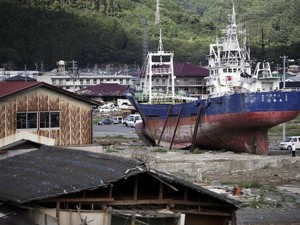
ECONOMY DAMPENER In this Sept. 6, 2011, photo, a ship sits amid houses almost six months after it was left there by the March 11 tsunami, in Kesennuma in northeast Japan. The string of calamities that struck Japan, which is one of the Philippines’ top export destinations, is one of the factors that contributed to the IMF’s cutting of its 2011 and 2012 growth forecasts for the Philippines. The country’s less-than-expected performance in the first half was blamed on the slowdown in exports. AP Photo/Greg Baker
The International Monetary Fund has cut its 2011 and 2012 growth forecasts for the Philippines—and the rest of the world—as problems of ailing industrialized countries continue to weigh down the global economy.
The IMF now expects the Philippine economy to grow by 4.7 percent this year and 4.9 percent next year, compared with the previous forecast of 5 percent for 2011 and 2012.
In the latest issue of the World Economic Outlook, one of the IMF’s major publications, the multilateral agency said there were unexpected developments that dampened the performance of the global economy.
These included the realization that the stimulus measures in the United States failed to achieve its desired impact, and the persistent problems in the eurozone. Another was the string of calamities that struck Japan earlier this year.
The United States, Europe and Japan are some of Philippines’ biggest export markets and home to many Filipino workers, whose remittances largely fuel household consumption.
“In crisis-hit advanced economies, especially the United States, the handover from public to private demand is taking more time than anticipated,” the IMF said. “In addition, sovereign debt and banking sector problems in the Euro area have proven much more tenacious than expected.”
Dennis Botman, IMF country representative for the Philippines, said that in reducing the 2011 and 2012 growth forecasts for the Philippines, the multilateral agency took into account the country’s actual performance in the first half of 2011, which fell short of expectations.
“The revision is due to the weaker-than-expected second-quarter 2011 growth outturn, the downward revision to first-quarter growth, and less benign global growth outlook,” Botman said in an e-mail to the Inquirer.
According to the latest government report, the Philippine economy grew by 3.4 percent in the second quarter. The report likewise said that the country’s growth in the first quarter was actually only 4.6 percent and not 4.9 percent as earlier announced.
With the resulting 4-percent average growth of the economy in the first half, the government would be hard pressed to meet its full-year target of 5 to 6 percent.
The country’s less-than-expected performance in the first half was blamed on the slowdown in exports, as the fiscal crisis in the West dampened global demand for Philippine-made goods.
The feeble first-half figure was also attributed to the government’s weak spending.
But the International Monetary Fund said that it also reduced the growth projections for other countries, apart from the Philippines.
Average growth of Asean economies was reduced from 5.4 to 5.3 percent this year, and from 5.7 to 5.6 percent next year.
Growth projection for the global economy had also been reduced from 4.3 to 4 percent in 2011, and from 4.5 to 4 percent in 2012.
Last week, the Asian Development Bank likewise cut its growth projection for the Philippines.
ADB now expects the country to grow by 4.7 percent this year, from an earlier forecast of 5 percent.
Next year, the institution expects the economy to grow by 5.1 percent.

